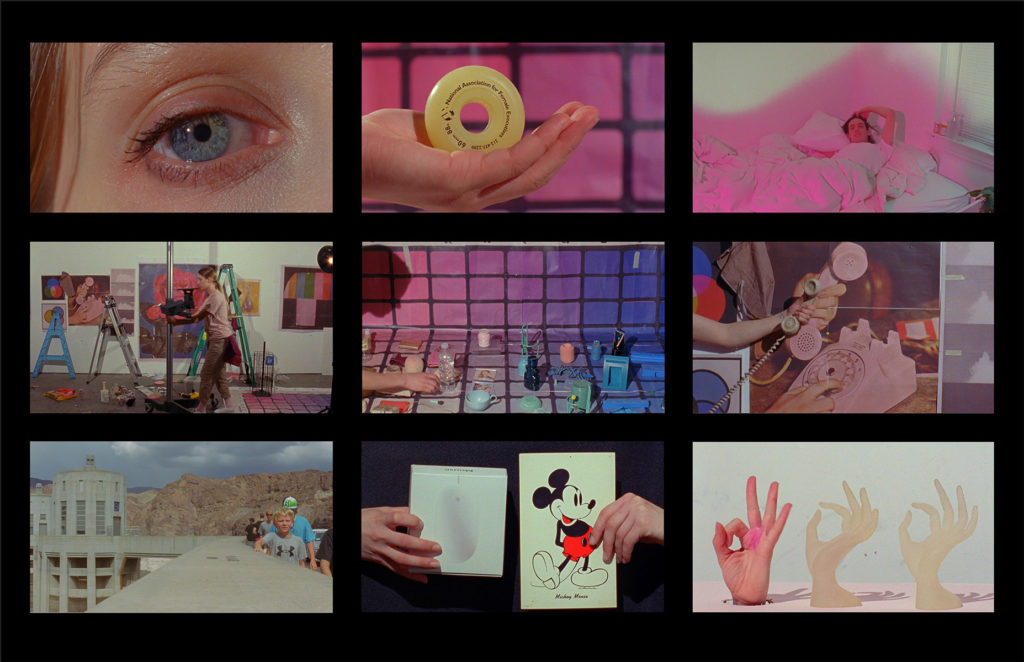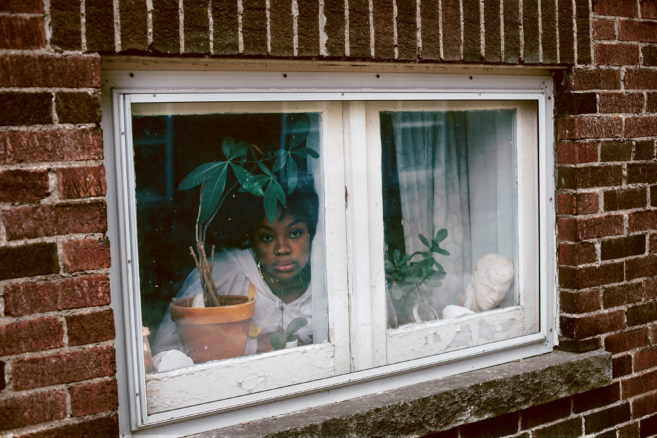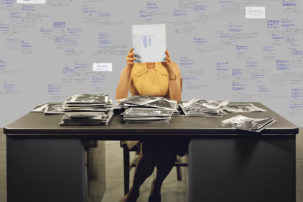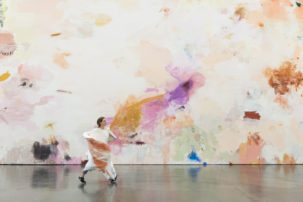ELIZABETH ZVONAR: You’re from Vancouver originally and did an English literature degree at UBC before moving to Toronto to get your bachelor of design from York University. You then went on to Yale for an MFA, and now you live in Brooklyn. Was being an artist your end goal the whole time or did life lead you there, piece by piece?
SARA CWYNAR: I got there piece by piece, although all along I desperately wanted to move to New York. I was a kid who grew up on magazines, living in a small city (Ottawa) just before the internet exploded our access to other worlds. I saw New York through the very particular and privileged world of fashion magazines: as the epicentre of all things cultural, and I wanted to be there. New York is actually one of the few things about being an adult that has fully lived up to my expectations! I studied English because I didn’t know what else to do and I just really loved reading; then with design I was sort of inching closer to art but still too scared to fully go for it. I got into Yale for photography on the second try. This was the first time I gave myself permission to consider myself an artist. It took me a long time. What was your trajectory to being an artist? Was it something you always knew and wanted, or did it come later? I read that you’re from Thunder Bay and I wondered about the art scene there—how did you figure out you wanted to go to art school?
EZ: I had some exposure to art when I was growing up and I naturally gravitated to creative activities. I was definitely encouraged to follow my instincts at my own pace. I left Thunder Bay as a teenager with my family and we moved west. My educational journey was made up of short stints with long swaths of travel in between. Eventually I returned to Vancouver to finish my BFA at Emily Carr. I think a large influence for me was the people I met along the way, while travelling and working in the places I found myself. I was wandering a bit, not quite focused on the future. I ended up meeting a lot of amazing people who were living lives that you could never plan for. It was quite an organic process of elimination. I stick to things I like to do even at the expense of financial stability. I think of it as creative problem solving, although there are definitely flaws to my logic.
SC: I remember first being super floored by your work in 2013, when you had the “Banal Baroque” show at Daniel Faria Gallery; I found the works to be so beautiful and smart. I particularly remember the piece Blind Love (2013). Do you think you can explain why your works look a certain way? Or is it an intuitive process that comes out of research?
EZ: I love that you were into that show. I feel like Blind Love was a sleeper piece—the image of the blinds and the cutout “lovebirds” and the opulent still life. It is easy on the eyes but you have to really look at it to catch what’s going on. I placed a sculpture with it, Clusterfuck (2013), a grouping of six white, gold-tipped porcelain cast elbows with a sploogy glaze; they looked like abstracted breasts with a derriere crack. These were also beautiful to look at; the pairing with the collage was intended to be bordering on too much, but still palatable. My personal taste is evident in the elements I work with, and I definitely work intuitively.
I first saw your work at MoMA PS1 in 2015. It totally stood out. I loved it, particularly Gold – NYT April 22, 1979 (Alphabet Stickers) (2013). I like how you don’t hesitate to repeat an object and embrace a colour throughout a piece. I have since had the opportunity to see some of your film work. Conceptually, there’s a lot going on and yet you don’t skimp on aesthetics; your work is very visually seductive, which sets up the conditions to listen to what you’re saying. It’s thought-provoking. This is a really difficult combination to get right. Would you say your experience working on staff as a designer at the New York Times Magazine was a practical study in how to present ideas to an audience?
“Beauty is a good way to engage an audience about ideas they might not spend much time ruminating on, such as feminism or Marxism. This is something unique to art.”
SC: I definitely think working at the New York Times and having a graphic design degree had a huge effect on the way I combine aesthetic pleasure with information. In design, and at the Times especially, you are often given a huge amount of information—a long-form journalism piece with 50 photographs of an event, for example—and then you’re asked to distill it into something easily digestable. The goal is to convince the reader to want to read your layout over everything else they might be looking at. In order to achieve that, the design has to attract.
When I think about what I do, I feel that if I am going to have the hubris to make art and imagine someone might care enough to look at it, I want to give some pleasure in the viewing experience. I wonder sometimes if it is a deeply ingrained female obligation to provide or to please. Although I think ultimately I would rather make work that provides a strong aesthetic experience while still incorporating the layers of research and conceptual content that go into making art rather than not.
Beauty is a good way to engage an audience about ideas they might not spend much time ruminating on, such as feminism or Marxism. This is something unique to art—art does something that other creative endeavours cannot. There is a logic when something is beautiful. The way you and I make art is about combining things that are totally random until they make sense together. Aesthetic pleasure lends authority to images and objects partly because it resonates with our senses, although I think we are often taught to think the opposite: if it’s uglier or plainer, it’s more serious, and therefore more smart. I don’t think so!
Your work is very beautiful to look at but also clearly has a research element and a deep knowledge of a history of representation. Do you worry that some of this research gets lost, or taken less seriously, when it is presented through a beautiful image or object?
EZ: I wonder if, in fact, it’s that the idea is beautiful and the work is more of a calculated aesthetic because the work is about inviting the viewer in. When I’m working in the studio, my process resembles building a puzzle. When all the pieces fit together there’s a mental satisfaction that happens that requires the visual and the conceptual to make a match; those two aspects need each other to work. It’s definitely an intuitive process that comes out of informal research. I guess my position is that if I’m convinced by the work then I’m not too concerned about how it’s received. There’s always going to be a loss in translation between what an artist intends and how someone will receive it. We make work and hope that there is an effort put into the receiving end of it, but we can’t control that reception. Perhaps art is setting up the conditions to get someone to stay, and a big part of that is beauty and aesthetics.
I value the agency I have, as an artist, to determine what I do every day; at the same time, I can also feel overwhelmed by choice and opportunity or lack thereof, coupled with an uncertainty of means. Sheila Heti wrote about your working method: “The artist has time, but no money. The consumer has money, but no time.” As artists who use objects and images that already exist, we have to re-present this stuff of the world in which we live in some kind of new way.
 Sara Cwynar, Rose Gold (stills), 2017. 16 mm film on video with sound, 8 min. Courtesy Cooper Cole/Foxy Production, New York.
Sara Cwynar, Rose Gold (stills), 2017. 16 mm film on video with sound, 8 min. Courtesy Cooper Cole/Foxy Production, New York.
SC: I think about this a lot. There’s so much stuff in the world. It is meaningful to take all the stuff that surrounds and overwhelms us and flip it, to try to see it more clearly. I want to respond to it, not ignore it. This requires participating in capitalism through activities like shopping, as Sheila points out—being a part of the thing you are critiquing. This has been a generative and difficult question in my work, one I addressed in Rose Gold (2017) particularly: How can you critique something even as you are being seduced by it? And can you really be an artist within this system or are you just a kind of culture worker? There is something inherently anti-capitalist about working for yourself, about willing to live precariously for that. We are also in a moment within neoliberalism when the ultimate worker is modelled after the artist, someone whose work is their vocation. I don’t know how to feel about it all. I agree there’s a constant pull between the joy of being an autonomous worker and the great privilege of being personally invested in the work you do, versus the constant threat that it might all just be ridiculous or about to go away or be too obscure to mean something or be feeding something bad. People in the art world love to remind you that success is fickle and fleeting, which, frankly, just annoys me at this point!
EZ: The problem is that people outside of this precarious art-world system might admire what they see as a lifestyle, but they can’t actually fathom a life like it. Or the sentiment is the opposite: they can’t even see the value in creative pursuits and certainly wouldn’t wish this existence on their own kin. As you point out, the inherent instability of what we do is really no different in structure than the myriad forms of contract work, which very likely have more transparent transferrable skills. We’re just on the rarified-interest end of it, which has pros and cons. Building an appreciation for culture into early-childhood-education models would help out a future cultural understanding and appreciation, and maybe expose the tricky misconception that artists are the ultimate workers. And then there is the looming threat that this is, in fact, ridiculous.
Having said that, I recently had this great experience of loving the process of making a big mural in my studio. It spans five feet by seven feet and took about six days to complete. It comprises a whole bunch of images from magazines that I pinned to one wall to figure out the combinations to make pictures with two or three elements. I had been looking at this stuff for about a year and was very familiar with it. I moved pieces from a small wall over to a larger one and started to compose the work, a little blindly. The process was so much fun for me. I found a flow that I had been out of touch with for a long time. I think that was in part because of a lack of focus I have with my improvised-studio dilemma—my studio is also my home, due to the precarity of living in Vancouver. What are the conditions that allow your work to flow in the studio?
SC: I have a similar situation. I have a studio that is way too small for me right now and I often feel like I can’t really see what I’m doing until it’s finished. My process is that I like to get a bunch of objects and images prepped in the studio, clear a space and then see what happens between them. Increasingly, I have been focused on video, and I find that this is a really different process where the same coming together happens outside the studio, through editing. I start with a lot of information and then whittle it down. I shoot tons of footage, comb it and recombine it until it becomes shorter and tighter over many passes. This is an overwhelming and very difficult way to work but I find it to be very generative. I am about to move to a much bigger (subsidized!) studio after about six years in the small one, which will be a godsend. I am very curious to see how this might change my work.
EZ: I’ve had some bigger spaces in the past, outside of where I live. I tend to switch between living in my studio and needing a separate space every five years or so. It’s an impossible, neverending conundrum though. I feel like I spend a lot of time thinking through how to make something happen efficiently. If I’ve honed any skill at all it might be finding the most efficient way to complete a task before embarking on a project or before thinking through the various phases of a project’s process. It doesn’t mean that I’m necessarily correct; it is simply a workaround born out of necessity. I don’t have the space or the means to make major gaffes. I’ve found in the past though that some mistakes turn out to be beautiful ideas. It’s a classic catch-22.






